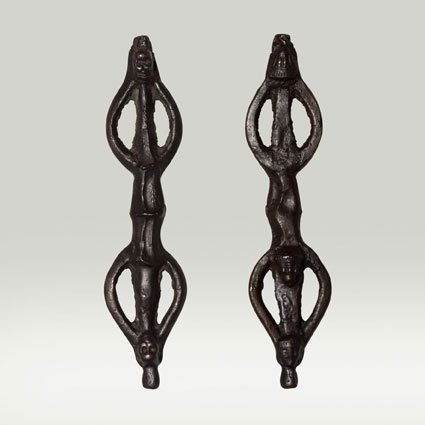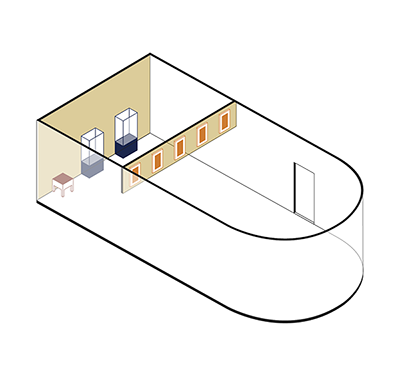ABR 039
Code: ABR 039
Country: Tibet
Style:
Date: 1200 - 1300
Dimensions in cm WxHxD: 3.6 x 15.5
Materials: Iron
Three-pronged Vajra
The vajra, or dorje in Tibetan, is the most common ritual object in tantric Buddhism, giving its name to Vajrayana Buddhism. Originally designating the thunderbolt, attribute of god Indra, in Buddhism it is the diamond—transparent, luminous and indestructible—like the nature of awakened mind. All vajras share the same overall structure with different elements (sphere, lotus petals, makara sea monsters, prongs) endowed with deep symbolism. This three-pronged vajra presented here has three points representing the Body, Speech and Mind of all Buddhas. Some models have one, five, seven, or nine prongs, each with a specific symbolism. Considered a male symbol of "skillful means" allowing to help all beings to progress towards Buddhahood, practitioners always hold it in their right hand, and it is associated with the bell, female symbol of vacuity and wisdom, held in the left hand.
An unusual form in Tibet more frequently encountered in Japanese Buddhism, this iron three-pronged vajra is marked with small skulls and was certainly used during wrathful rituals.
The vajra, or dorje in Tibetan, is the most common ritual object in tantric Buddhism, giving its name to Vajrayana Buddhism. Originally designating the thunderbolt, attribute of god Indra, in Buddhism it is the diamond—transparent, luminous and indestructible—like the nature of awakened mind. All vajras share the same overall structure with different elements (sphere, lotus petals, makara sea monsters, prongs) endowed with deep symbolism. This three-pronged vajra presented here has three points representing the Body, Speech and Mind of all Buddhas. Some models have one, five, seven, or nine prongs, each with a specific symbolism. Considered a male symbol of "skillful means" allowing to help all beings to progress towards Buddhahood, practitioners always hold it in their right hand, and it is associated with the bell, female symbol of vacuity and wisdom, held in the left hand.
An unusual form in Tibet more frequently encountered in Japanese Buddhism, this iron three-pronged vajra is marked with small skulls and was certainly used during wrathful rituals.


